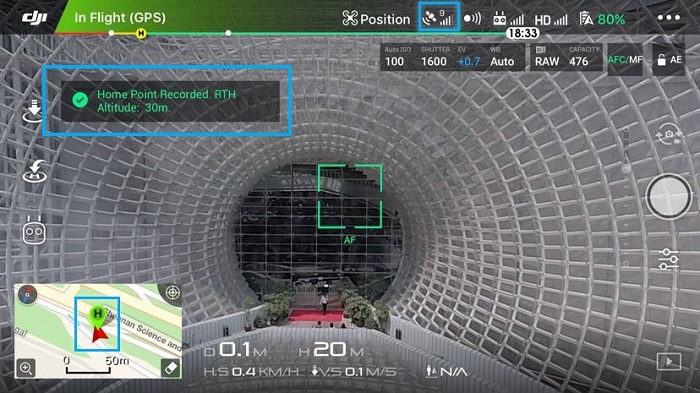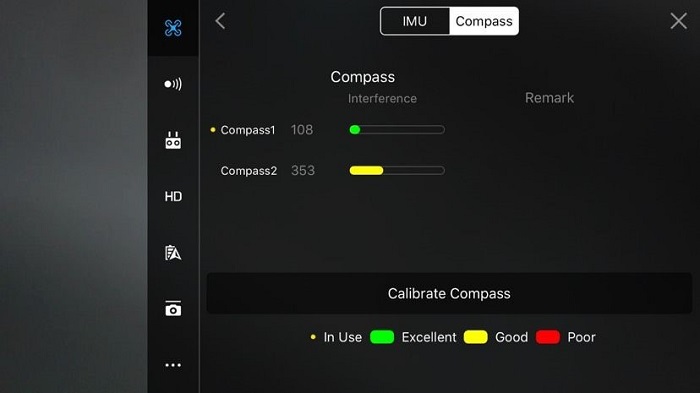Drone fly-aways, terrifying moments when your quadcopter suddenly loses it’s mind and decides to drift away on it’s own, are as hard to explain as the missing drones are to find. Fly-aways are incredibly frustrating events for UAV pilots, not just for the sheer expense of alost drone, but also because they are so unpredictable.
Manufacturers tell us that the causes of drone fly-aways vary, but are usually due to pilot error. Flying to far from the controller, or flying around obstacles at a distance are high on the list of causes. Operating near areas of interference like power lines or communications towers is another.
As companies like DJI push more and more drones out the door, the number of reported fly-aways is increasing going by the chatter we see in the forums.
What can you do to prevent a drone flyaway? Lots.
DJI Support published an instructable at the start March, entitled 5 Ways To Prevent Flyaways, in response to the high numbers of pilots that were experiencing wayward drones. While some flyaways could potentially be linked to device malfunction, it’s even more likely that many flyaways are the result of either pilot error or lack of experience, or both.
These best practices basically sum up some simple, common sense behaviours (most of which are pre-flight) that raise the likelihood that you and your drone will survive a “flyaway”.
#1. Before you launch, make 100% sure you have set your home point.
If you want your aircraft to automatically return home, make sure a home point is set before you take off! You’ll need at least 4 GPS signal bars. Once a Home Point is set, you’ll see a prompt in the app, and a green Home Point icon will appear on your map.

2. Watch Out For Compass Interference
GPS signal is necessary but not sufficient for your drone to return to home safely. Your drone’s compass also needs to be relatively free from interference. GPS only determines the drone’s location; the compass determines its orientation. If you initiate RTH, your aircraft will turn its head and fly back to the Home Point. But if it doesn’t know which way to turn, it may end up flying somewhere else.
The DJI GO app will warn you if compass interference is too great. You can also see the amount of interference in your area in MC Settings – General – Compass. The Mavic and newer DJI drones have redundant compasses, but if one or both of them are in the red, it’s a good idea to recalibrate, or move to an area with less interference.
If you’ve ever traveled to the ‘red rock’ areas of Arizona, with the high iron content in the soil, you can appreciate how they can affect compass navigation. Cell phone and other communication towers, and even other drone users in the area can impact on the quality of your signal.

3. Keep Your Drone Within Line of Sight
Your drone is much less likely to crash or get lost if you can see it with your own eyes. There are good reasons why flying within line of sight is included in the FAA’s UAV operation rules. Monitoring your drone solely through your live video feed is never a good idea. If you do this, you won’t be able to see what’s behind or to either side of your drone. Sometimes “flyways” are just accidents resulting from the drone not being visible. Fly within line of sight and stay safe!

4. Reset Your Home Point if You’re Moving
As long as you have sufficient GPS signal, your Home Point will be set automatically when you take off. However, it won’t reset automatically if you move around. If you’re driving in a car or moving in a boat, you’ll need to reset your Home Point periodically. This gif shows you one way to reset your Home Point:

5. Set an Appropriate RTH Altitude
Even though DJI’s newer drones have vision systems that allow the drones to fly over or around obstacles during RTH, it’s still a good idea to set an RTH Altitude. For one, the obstacle sensors won’t work in low-light situations, and pure glass surfaces and water may not be detected. Also, the obstacle avoidance sensors may not detect thin objects like tree branches or power lines.

Some DJI drone pilots have shared their best practices with us as well, on how to prevent (or at least manage) a drone flyaway. In addition to the above recommendations by DJI, we’ve added a few more:
6. Practice in Manual Mode
Flying only within line-of-sight (LOS) is now the law in some areas. So If you’re flying within LOS and you lose video signal you will need to pilot the drone back without the benefit of any feeds, video or otherwise. Take time to practice flying your quadcopter in a manual flight mode to have a strong feel for your controls and the ability necessary to get your machine home.
7. Pre-Flight Routine
On weekends I love shooting skeet, and one of the guys I meet at the range is a professional pilot who spends his days “in the office” looking out the window of a Boeing 737. We were talking about drones recently(he has a Mavic Pro and a Phantom 4 Pro) and the conversation drifted around to pre-flight checklists…something he is intimately familiar with.
What is your pre-flight routine? Do you have a disciplined, repeatable process that you follow prior to each flight? Have you read and re-read the manufacturer’s manual for your UAV to the point where you have a deep understanding of how to properly use it safely?
Finally, remember that there are several digital brains trying to work together to keep your drone airborne. Whether you have an iPad or other tablet attached to your controller, or a smartphone remember that these devices often have apps running in the background. Worse, it’s possible you left other apps running that are using up or competing with your drone for computing space. Until the true root causes of fly-aways are determined, take the approach that it could be something as simple as push notifications coming into the phone from social networks like Twitter or Snapchat, or the device itself hunting for an update. Closing all of your apps and disabling push notifications, then rebooting your tablet or smartphone prior to commencing your pre-flight routine is probably a decent idea as well.
If you’ve experienced a fly-away, let us know the circumstances in the comments. Did you contact DJI? What was their response?


